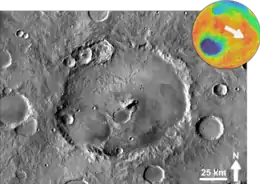Müller (Martian crater)
Müller is a 120.5 kilometer crater in the Martian southern hemisphere, at 25.74°S, 127.89°E,[1][2] located in the Terra Cimmeria region of the Mare Tyrrhenum quadrangle of Mars.[3] According to the International Astronomical Union's Working Group for Planetary System Nomenclature, Müller is jointly named for Hermann Joseph Muller, an American geneticist and anti-nuclear weapons activist, and Carl H. Müller, a German astronomer.[1] Ejecta from the Müller crater divides two Noachian era drainage basins.[4]
 Martian impact crater Müller based on THEMIS image. | |
| Planet | Mars |
|---|---|
| Coordinates | 25.74°S 127.89°E |
| Quadrangle | Mare Tyrrhenum quadrangle |
| Diameter | 120.51 km |
| Eponym | Hermann Joseph Muller and Carl H. Müller (German astronomer) |
Muller Crater has a central peak. Impact craters generally have a rim with ejecta around them, in contrast volcanic craters usually do not have a rim or ejecta deposits. As craters get larger (greater than 10 km in diameter) they usually have a central peak.[5] The peak is caused by a rebound of the crater floor following the impact.[6] Its rim has probably been eroded away.
References
- "Müller". Gazetteer of Planetary Nomenclature. USGS Astrogeology Research Program.
- Bob Kanefsky. "Roving Mouse Mars Atlas".
- Anthony Laudun (2014-02-15). "Small Pale Red Planet Issue 6 Phase 7; The Mare Tyrrhenum Region".
- Rossman P. Irwin III & Alan D. Howard (2002). "Drainage basin evolution in Noachian Terra Cimmeria, Mars". Journal of Geophysical Research. 107 (E7): 5056. Bibcode:2002JGRE..107.5056I. doi:10.1029/2001JE001818.
- "Stones, Wind, and Ice: A Guide to Martian Impact Craters".
- Hugh H. Kieffer (1992). Mars. University of Arizona Press. ISBN 978-0-8165-1257-7. Retrieved 7 March 2011.